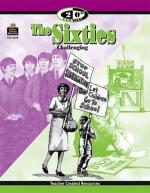|
This section contains 279 words (approx. 1 page at 300 words per page) |

|
As with other areas of American popular culture, fashion underwent a real transition in the 1960s, from conservatism to excess, from social conformity (doing what society expects) to individuality ("doing your own thing"). The fashion icon (symbol of fashion) of the first years of the decade was first lady Jacqueline Kennedy (1929–1994), wife of the popular young president John F. Kennedy (1917–1963). Jacqueline Kennedy, with her simple yet tasteful clothes, was featured in most of the popular fashion magazines of the day. However, the refined conservatism of the first lady soon gave way to much bolder styles.
Around 1964, British designer Mary Quant (1934–) designed the "mod look," which became especially popular among young women. Miniskirts, brightly colored dresses, dark eye makeup, and wild blouses, stockings, and accessories became the rage. Styles shifted rapidly from year to year. A thin, mod British model named Twiggy (1949–) soon replaced Jackie...
|
This section contains 279 words (approx. 1 page at 300 words per page) |

|



